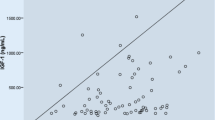Abstract
To assess the disease activity of acromegaly in patients, we measured the changes in serum growth hormone (GH) levels during oral glucose tolerance test and the basal serum levels of insulin-like growth factor I (IGF-I) and insulin-like growth factor-binding protein 3 (IGFBP-3) in 29 acromegalic patients and 30 health persons served as normal controls. Based on the clinical and laboratory criteria, acromegaly was in an active state of disease in 18 patients and was inactive in the other 11 patients. Basal serum IGF-I levels were 177±116 ng/ml (mean±SD), 250±135 ng/ml and 810±297 ng/ml in the normal subjects, the inactive and active acromegalic patients, respectively. Basal serum IGFBP-3 levels were 1.71±1.29 μg/ml, 2.98±0.96 μg/ml and 6.82±1.31 μg/ml in the normal controls, the inactive and active acromegalic patients, respectively. Serum levels of IGF-I and IGFBP-3 significantly correlated with each other in the normal subjects as well as the patients. Both IGF-I and IGFBP-3 levels were significantly higher in the group of patients with active acromegaly than inactive acromegalic patients and the normal subjects but there was not statistically difference between the normal controls and the inactive acromegalics. While serum IGF-I levels presented considerable overlapping instances among the three groups, the serum IGFBP-3 of inactive patients and the normal controls could rarely reach 4.44 ng/ml, the lowest value of the active acromegalics. The serum IGF-I and IGFBP-3 levels declined with increased age in normal controls, but not in the patients with acromegaly. There was no sex predilection of serum IGF-I and IGFBP-3 found in our study. The results of this study indicated that the serum IGFBP-3 level is an important laboratory parameter for assessing growth hormone function in humans, and might be a more reliable discrimination for the disease activity of acromegaly than the serum IGF-I is.
Similar content being viewed by others
References
Melmed S. Acromegaly. N. Engl. J. Med. 322: 966, 1990.
Jaquet P., Guibout M., Jaquet C., Grisoli F., Devolx B.C., Dumas D., Bert J. Circardian regulation of growth hormone secretion after treatment in acromegaly. J. Clin. Endocrinol. Metab. 50: 322, 1980.
Barkan A.L., Stred S.E., Reno K., Markovs M., Hopwood N.J., Kelch R.P., Beitins I.Z. Increased growth hormone pulse frequency in acromegaly. J. Clin. Endocrinol. Metab. 69: 1225, 1989.
Hartman M.L., Veldhuis J.D., Vance M.L., Faria A.C.S., Furlanetto R.W., Thorner M.O. Somatotropin pulse frequency and basal concentrations are increased in acromegaly and are reduced by successful therapy. J. Clin. Endocrinol. Metab. 70: 1375, 1990.
Grisoli F., Leclercq T., Jaquet P., Guibout M., Winteler J.P., Hassoun J., Vincentelli F. Transsphenoidal surgery for acromegaly: Long-term results in 100 patients. Surg. Neurol. 23: 513, 1985.
Serri O., Somma M., Comtois R., Rasio E., Beauregard H., Jilwan N., Hardy J. Acromegaly: biochemical assessment of cure after long term follow-up of Transsphenoidal selective adenomectomy. J._Clin. Endocrinol. Metab. 61: 1185, 1985.
Clemmons D.R., Van Wyk J.J., Ridgway E.C., Kliman B., Kjellberg R.N., Underwood L.E. Evaluation of acromegaly by radioimmunoassay of somatomedin-C. N. Engl. J. Med. 301: 1138, 1979.
Rieu M., Girard F., Bricaire H., Binoux M. The importance of insulin-like growth factor (somatomedin) measurements in the diagnosis and surveillance of acromegaly. J. Clin. Endocrinol. Metab. 55: 147, 1982.
Conover C.A. Potentiation of insulin-like growth factor (IGF) action by IGF-binding protein-3: Studies of underlying mechanism. Endocrinology 130: 3191, 1992.
Baxter R.C. Insulin-like growth factor (IGF) binding proteins: The role of serum IGFBPs in regulating IGF availability. Acta Paediatr. Scand. 372: 107, 1991.
Jones J.I., Clemmons D.R. Insulin-like growth factors and their binding proteins: Biological actions. Endocr. Rev. 16: 3, 1995.
Juul A., Main K., Blum W.F., Lindholm J., Ranke M.B., Skakkebaek N.E. The ratio between serum levels of insulin-like growth factor (IGF)-I and the IGF binding proteins (IGFBP-1, 2 and 3) decrease with age in healthy adults and is increased in acromegalic patients. Clin. Endocrinol. (Oxf.) 41: 85, 1994.
Grinspoon S., Clemmons D., Swearingen B., Klibanski A. Serum insulin-like growth factor-binding protein-3 levels in the diagnosis of acromegaly. J. Clin. Endocrinol. Metab. 80: 927, 1995.
Baxter R.C., Martin J.L. Radioimmunoassay of growth hormone-dependent insulin like growth factor binding protein in human plasma. J. Clin. Invest. 78: 1504, 1986.
Blum W.F., Ranke M.B., Kietzmann K., Gauggel E., Zeisel H.J., Bierrich R. A specific radioimmunoassay for the growth hormone (GH)-dependent somatomedin-binding protein: its use for diagnosis of GH deficiency. J. Clin. Endocrinol. Metab. 70: 1292, 1990.
Zapf J. Walter H., Froesch E.R. Radioimmunological determination of insulin like growth factors I and II in normal subjects and in patients with growth disorders and extrapancreatic tumor hypoglycemia. J. Clin. Invest. 68: 1321, 1981.
Daughaday W.H., Rotwein P. Insulin-like growth factors I and II. Peptide, messenger ribonucleic acid and gene structures, serum, and tissue concentrations. Endocr. Rev. 10: 68, 1989.
De Herder W.W., Van der Lely A.J., Janssen J.A.M.J.L., Uitterlinden P., Hofland L.J., Lamberts S.W.J. IGFBP-3 is a poor parameter for assessment of clinical activity in acromegaly. Clin. Endocrinol. (Oxf.) 43: 501, 1995.
Jorgensen J.O., Moller N., Moller J., Weeke J., Blum W.F. Insulin- like growth factor (IGF)-I and -II and IGF binding protein-1, -2, and -3 in patients with acromegaly before and after adenomectomy. Metabolism 43: 579, 1994.
Van der Lely A.J., Harris A.G., Lamberts S.W.J. The sensitivity of growth hormone secretion to medical treatment in acromegalic patients: influence of age and sex. Clin. Endocrinol. (Oxf.) 37: 181, 1992.
Author information
Authors and Affiliations
Rights and permissions
About this article
Cite this article
Chen, H.S., Lin, HD. Serum IGF-I and IGFBP-3 levels for the assessment of disease activity of acromegaly. J Endocrinol Invest 22, 98–103 (1999). https://doi.org/10.1007/BF03350887
Accepted:
Published:
Issue Date:
DOI: https://doi.org/10.1007/BF03350887




